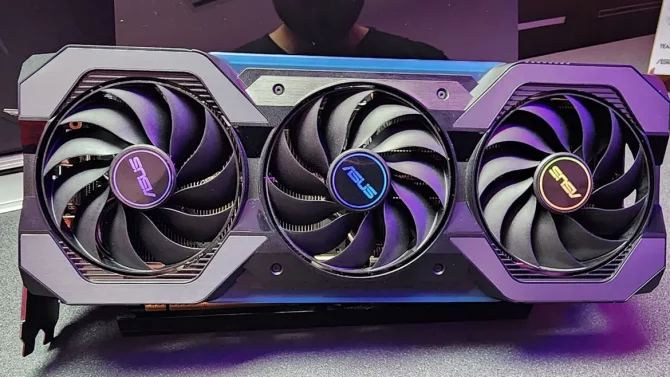
ASUS Exhibits Concept GeForce RTX 40 Graphics Card Devoid of Power Connectors, Utilizing Proprietary Slot
ASUS is expanding its connector-less design to encompass graphics cards and has unveiled its initial GPU, a GeForce RTX 40 model, which now eschews power plugs.
ASUS is Preparing GeForce RTX 40 Graphics Cards That Lack Power Plugs, Employing Proprietary-Slot Instead
During our visit to the ASUS headquarters, the ROG team afforded us an exclusive preview of an upcoming graphics card (presently in the conceptual phase) that forms part of the GeForce RTX 40 family. The graphics card in question bore the design of a GeForce RTX 4070, yet it does not belong to any of the existing VGA product lineups, boasting an intriguing aesthetic.
ASUS Unveils Conceptual GeForce RTX 4070 GPU Without Power Connectors
Thus, the graphics card itself possesses a 2.3-slot configuration, showcasing a triple axial-tech cooling fan system. Once more, it does not align with any captivating GPU series from ASUS, such as ROG STRIX, TUF Gaming, Dual, and the like. The reverse side of the card exhibits an extended backplate, surpassing the PCB, with an aperture facilitating the passage of air. Furthermore, the card is equipped with a dual-BIOS switch, permitting seamless transitions between Performance and Quiet modes. While the backplate features the moniker Megalodon, we were informed that it does not represent the final branding for this card.
The most intriguing aspect of this graphics card lies in the fact that, in addition to the standard PCIe Gen 4.0 x16 slot, it incorporates a unique slot connected to the PCB, which serves as the conduit for the power supply. Physical connectors are absent from the PCB, and we will elucidate the power source in due course. ASUS informed us that this slot is proprietary, although a similar slot implementation has been observed in AMD’s Radeon Pro offerings for Apple Pro systems.
The connector possesses a power delivery rating of up to 600W, employing a distinct connector available on a select range of motherboards.
ASUS Z790 TUF Gaming ATX Motherboard With Back-Connector Design
For demonstrative purposes, ASUS also unveiled a Z790 TUF Gaming motherboard that omits power connectors at the front, positioning them at the rear instead. The connector-less design of the Z790 TUF Gaming motherboard also incorporates three 8-Pin connectors and a solitary 12VHPWR connector. These connectors directly supply power to the graphics card via the proprietary slot.
The motherboard itself exhibits a conventional Z790 TUF Gaming design, adhering to an ATX form factor. It features the LGA 1700 socket, a 16+1 phase VRM delivery with 60A MOSFETs, and all the latest I/O connectivity. Additionally, it offers two PCIe 4.0 x16 slots, two PCIe 4.0 x1 slots, and a lone PCIe 4.0 x4 slot. Only the uppermost PCIe 4.0 x16 slot is equipped with the proprietary connector. The motherboard also incorporates the PCIe-Slot Q-Release and boasts M.2 slots, each equipped with heatsinks and featuring the M.2 Q-Latch.
The connector itself is denoted as GC_HPWR. ASUS intends to assign a more official name to it closer to the launch.
According to ASUS, both of these motherboards are slated for a retail release later this year. Unlike the BTF connector-less motherboard offerings, which were limited to China, these two product lines are expected to be available globally.
Regarding pricing, while it is premature to determine the exact cost of these GPUs and boards, ASUS stated that they will be priced slightly higher than the regular SKUs due to the additional manufacturing costs incurred by the relocation and realignment of connectors on the PCB. Should you opt for the motherboard, virtually any graphics card will function suitably. However, if you acquire the new connector-less GPU, you must also obtain the corresponding motherboard, as no other design supports such a slot.
Photographs showcasing the ASUS connector-less motherboard and GPU installed within a chassis, from both the front and rear perspectives, are available for your perusal. It should be noted that the casing must also be custom-designed to accommodate the novel back-connector designs of forthcoming hardware. Initially, these products will undergo limited production runs, as companies still need to ascertain the market demand for such offerings.





